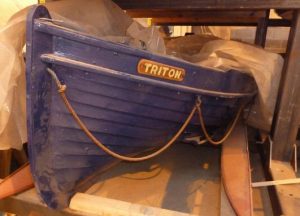 Triton is an open double ended ship’s lifeboat which previously belonged to the pre-war tug Triton, which in the 1970s was used as a seamanship school in St Katherine’s dock, London.
Triton is an open double ended ship’s lifeboat which previously belonged to the pre-war tug Triton, which in the 1970s was used as a seamanship school in St Katherine’s dock, London.
Such craft have a rather colourful history, in one sense going back hundreds of years to the ship’s boats carried by all large sailing craft for general purpose use and as a lifeboat when needs arose, but more recently to the Titanic disaster.
In April 1912 the Titanic sank with over 2300 passengers on board. When it became clear that under existing British laws no passenger ship was obliged to carry lifeboats for more than 1000 people there was a public outcry and within months lifeboats like this were being installed on board merchant and passenger ships.
Apart from the rope loops fastened externally to assist recovery from the water, early lifeboats carried little survival equipment: brandy, fresh water, biscuits enough for a few days at sea, sometimes simple oil lamps to be seen by rescuers at night, and bags full of oil to calm stormy waters.
By the Second World War, however, there had been a dramatic improvement and stores included water held in special tanks, milk tablets, dried meat, chocolate and other survival rations. Lifejackets, survival suits, distress flares and hand cranked radios also greatly improved the sailors’ chances of survival at sea.
Dimensions
Length 5.54m
Beam 2.15m
Draft 0.62m


